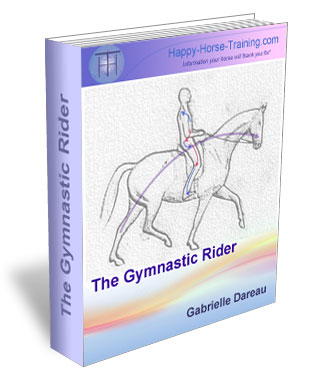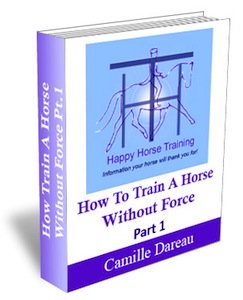| Back to Back Issues Page |
 |
|
The Whole Horse News - HHT International Clinics April 29, 2015 |
HHT International Horse Riding Clinics
Spotlight On Training
This year Happy Horse Training has started giving horse riding clinics internationally. This is an exciting opportunity for HHT's founders, Camille and Gabrielle Dareau, to take their methods to riders and horse-owners in their own location, with the advantage for both riders and spectators of experiencing their teaching directly.
We continue to offer residential teaching specializing in training on the lunge at our base in the South-West of France, but international riding clinics add another dimension to how we can share our message. After the initial UK clinic in March, our next date is the 17th - 21st June at Distinction Ranch in California, where we are honored to be hosted by Len Judd and Bethany Peppani-Judd. You can also look at the facebook event page for the clinic. We are then planning a two-day clinic in the Haute-Vienne region of France in October, and then a return visit to the UK later the same month. If any of these clinics interests you, either as a participant or an auditor, go to this page on the HHT site for more information and contact details. If you are interested in organising a clinic yourself, please get in touch with us by email: contact@happy-horse-training.com.

Tristan and Camille in a chilly Gloucestershire! The first HHT clinic this year took place in Gloucestershire, England, where Camille gave two days of individual lessons. Despite the freezing cold conditions, there was very positive feedback from all participants, and everything ran smoothly thanks to an excellent organization by Fiona Allen. HHT is also fortunate to have the assistance of Tristan MacGregor as photographer, which meant that each rider could receive a visual record of their lesson. Every horse and rider combination underwent a marked transformation during their lessons. The most telling outcome was the increased relaxation of all the horses by the end of the sessions, some of whom were understandably very tense at the beginning, due to traveling and unfamiliar surroundings.
One of the most important things that come out of this clinic is the difference in HHT's approach to developing the rider's position as justified by feel rather than superficial appearances. Our whole method is based on developing the particular gymnastic interaction between horse and rider that promotes balanced movement, so our priority when teaching is the real postural effect the rider is having on the horse, instead of prioritizing a certain visual appearance of the position.
The validation for riders of the postural connection that we teach is the good feeling they get from all of these responses, in terms of both increased balance of the movement and a much deeper connection with horse. Forming the rider posture that is capable of genuinely altering the horse's balance for the better is above all a gymnastic development in the rider's body - for this reason it is impossible to expect riders to adopt all aspects of the correct riding position at once. The foundation of the rider's connection with the horse is the right seat orientation - the tucked pelvis - and this has to be the initial focus. When riders get this new positioning of their seat, they immediately feel a different, adhesive connection with the horse's movement, and the horse will feel the movement able to flow through more, because it is no longer being blocked by a seat that juts against it.
The point is that this is only a first stage, and the rider's position will transform increasingly towards the more classical appearance as a function of the real gymnastic development taking place: including the suppling of the hip joints, releasing of the Psoas muscle, strengthening of the postural core, and overall correction of postural unevenness and weaknesses.
 Another crucial focus of our teaching is the rider's lateral weight interaction with the horse's movement.
Another crucial focus of our teaching is the rider's lateral weight interaction with the horse's movement.
This is about recognizing how the horse's natural bodily articulation in movement pushes the rider's seat off-centre, resulting in imbalance. When riders learn how to prevent this misalignment, it fundamentally changes the whole biomechanical dynamic between horse and rider. This is another example of teaching based on gymnastic knowledge and feel rather than visual appearances, because the rider's weight distribution over the horse's spine is not visually obvious, before you learn to look for it, and it is seldom addressed in teaching.
Just like with the rider's posture, it is only by allowing the horse to work through each step of the postural development in turn - and for as long as is necessary to acquire the inner qualities that allow a progression to the next stage - that a genuinely advanced posture will eventually be achieved, instead of a fake show of one.
There is a strong tendency in dressage riding to focus of the outer appearance of horse and rider, but our experience has proven to us, time and time again, that it is only by letting go of this preoccupation that we allow ourselves to create a meaningful, dynamic connection with the horse, who's beauty grows and flourishes with time.
Parallels with Holistic Horse Care
Myth: a shiny horse is a healthy horse Understandably, many horse owners are attached to the idea of their horse looking perfectly shiny, spotlessly clean, and without a scratch, with a neat, short coat all year round. They are prepared to keep their horses shut in stables (or turned-out separately in grassy paddocks), rugged, clipped and fed an unnatural diet to promote this appearance. Many want their youngsters to appear 'developed' quicker than they would naturally, and like the look of 'well-furnished' horses who are actually obese and suffering from chronic laminitis. Such owners are prepared to feed high-sugar diets and even steroids to get this result. When people are used to a certain glossy appearance, they may even be convinced that these are all signs of well-being and good health, just as those who are used to the appearance of a shod hoof think that its deformation is normal. The horses appear to accept and enjoy this lifestyle of regular confinement because they are so conditioned to their routine. It is only if we're prepared to start letting go of these outer preoccupations that we will allow ourselves to see that the beauty is only skin-deep, and the well-being of the horse is suffering on many levels as a result.
If we want horses to be truly healthy, from the inside-out, we have to give them the stimulation that they have evolved over millions of years to respond to. Just like the inner qualities of gymnastic riding, we have to trust that the development of the inner qualities of health and well-being in the horse is a process. There many be periods of adaptation where things do not look perfect on the outside, but the important thing is that they are going in the right direction.
Just Click here to go to the HHT group page, and then click on the 'join group' button at the top right of the page.
Sharing the Holistic Message
If you enjoy the Happy Horse Training website, and you find the information on it useful, please help us to share it by clicking on the Facebook 'like' and 'share' buttons that are on each page (you can also share this newsletter by clicking on the symbol above). Any other way you can pass the site on to friends and colleagues, for example via discussion forums, is also greatly appreciated. You can also sign up to our RSS feed (blog) to be kept up to date with new ideas, pages and other information that we post there. Just click on the box that says 'subscribe to this site' at the left of each page. The equestrian world is one dominated by traditionalist ideas and conventions, but we would like to help inform the growing minority of horse-owners who want to make their horses happier with progressive and holistic methods.
Happy Horse Training now has over 100 pages exploring many different areas of holistic equitation. Do have a look through our site plan to find the subjects and categories that interest you.
Available from HHT:
New! The Gymnastic Rider eBook  Available exclusively from HHT, a unique and comprehensive guide to practical rider biomechanics. This professionally produced eBook takes the rider through the process of developing their body in the specific way that brings the horse's movement into harmony and balance, without force and constraint.
Available exclusively from HHT, a unique and comprehensive guide to practical rider biomechanics. This professionally produced eBook takes the rider through the process of developing their body in the specific way that brings the horse's movement into harmony and balance, without force and constraint.
The information in this book, including over 55 000 words, represents what we would normally pass on in a minimum of 12 specialist lunge lessons, focusing on each part of the position and its influence on the horse, with a value of at least €450. The Gymnastic Rider is available for only €29.99. Click here for full details, and to download the 15-page introduction to the book for free.
How to Train a Horse Without Force
eBook With your purchase you will receive a free bonus supplement on Horse Trauma - cutting edge insights on this subject that up until now have mostly been applied only to human trauma. This supplement shows how to recognise, avoid and deal with horse trauma, which is much more common that we realise. These two e-books - How to Train a Horse Without Force and Horse Trauma comprise more than 75 thousand words and are richly illustrated. They are available for only 19.99 Euros (around $26). Click here for more details.
|
| Back to Back Issues Page |






